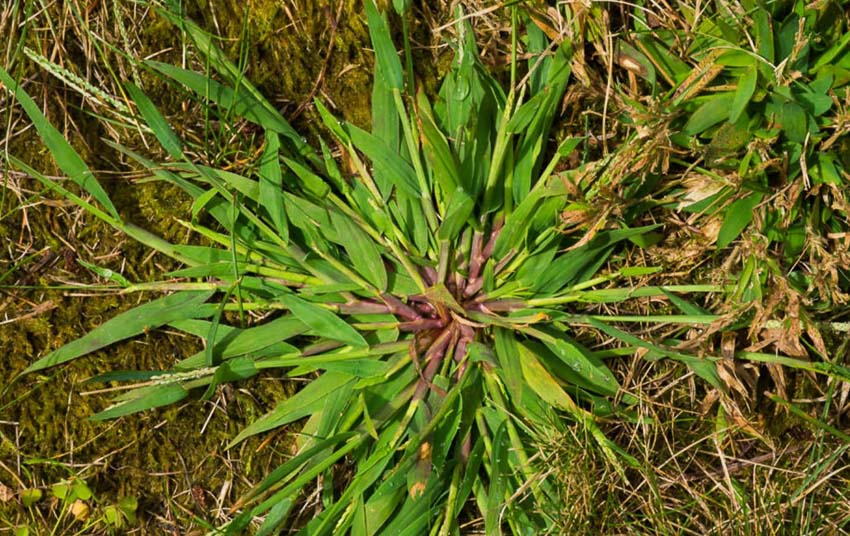Few battles are as fraught with failures and losses as a landscaper’s battle against crabgrass. This stubborn weed is a true bane to gardeners and lawn manicurists everywhere. Learn how to kill crabgrass in your lawn using herbicides or organic methods and prevent it from returning.
What is Crabgrass?
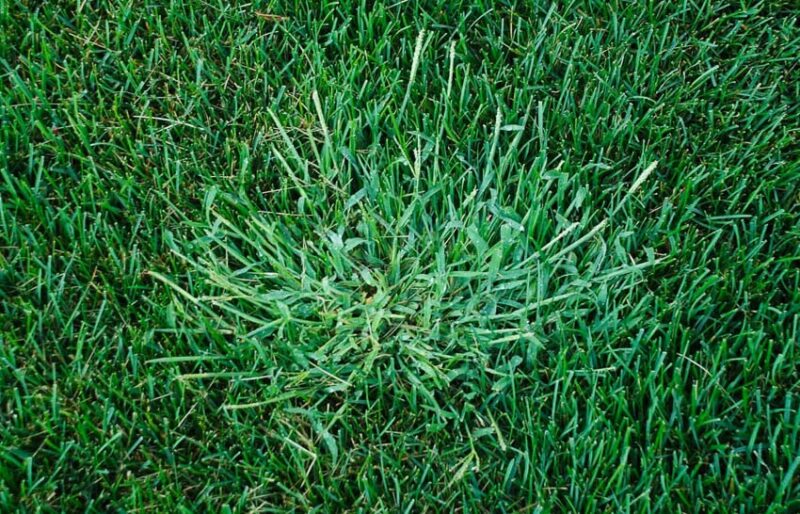
Crabgrass is a warm-season annual weed, sometimes called finger grass or fonio. It grows low to the ground in clumps that resemble crab legs, hence its common name. The yellowish-green color of crabgrass is highly visible on a dark green lawn.
In Africa, fonio has been grown for over 5,000 years and is regarded as a highly nutritious staple crop. The Patent Office introduced crabgrass into the United States as a forage crop in 1849.
Crabgrass is classified in the genus Digitaria, named after the Latin word for finger, digitus. There are at least 35 varieties of Digitaria, but only two are prevalent in the United States, hairy crabgrass and smooth crabgrass.
Hairy crabgrass (D. sanguinalis), also known as large crabgrass, and smooth crabgrass (D. ischaemum) are the two species that cause the most problems for people trying to grow lush green lawns. You do not need to distinguish between them when killing crabgrass.
Once you get rid of that crabgrass, learn how to dethatch, plant grass, grow grass in the shade, and fertilize your lawn!
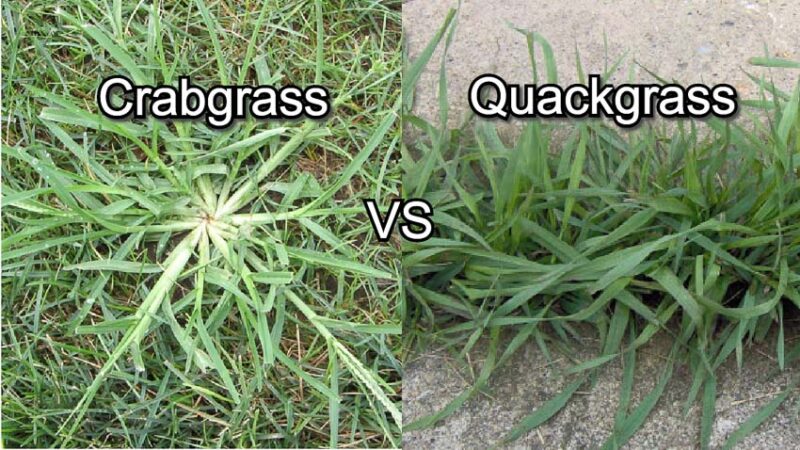
Many people confuse crabgrass and quackgrass, using their names interchangeably. Quackgrass (common couchgrass) is a cool-season perennial grass that propagates with deep rhizomes, and crabgrass is a warm-season annual grass.
Both cause significant problems in your lawn, but they have distinctly different growth habits and eradication methods.
Don’t miss out on our guides to getting rid of mushrooms and controlling for grubs in your yard!
The Crabgrass Growth Cycle
Understanding the growth cycle is the key to how to get rid of crabgrass in your lawn.
Digitaria species germinate in late spring and summer because they are warm-season annual grasses. They continue to thrive in warm weather, high temperatures, and drought conditions.
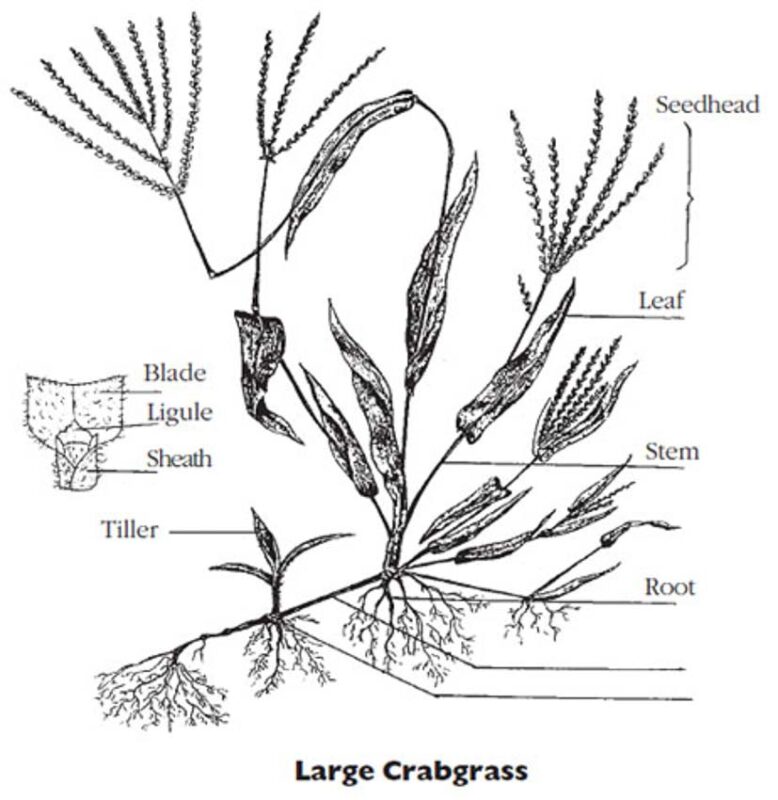
The reproductive stage of the crabgrass lifecycle begins as the days get shorter in late summer and fall. Growth slows, and the plants produce seed heads with thousands of seeds. Mowing won’t stop them from setting seed because crabgrass can go to seed when it’s a half-inch tall.
Crabgrass is drought-tolerant and resistant to high temperatures, so it thrives during the summer when your lawn is struggling. It spreads out and blocks the growth of your lawn grass, and without intervention, it can take over your lawn.
How to Prevent Crabgrass in Your Lawn?

As Benjamin Franklin said, “An ounce of prevention is worth a pound of cure.” Taking these preventive measures will enhance your efforts on how to kill crabgrass.
As Ben once said, “A penny saved is a penny earned.” Don’t miss out on our Guide to Lawn Care Cost!
Avoid Mowing Too Short
The goal is to prevent crabgrass seeds from germinating in your lawn. When you mow too short, you let light and warmth in, which creates optimum conditions for warm-season grasses to germinate.
Tall grass shades the soil and keeps your lawn cool, preventing warm-season grasses from germinating. Adjust your mower blades to about three inches during peak growing conditions to keep the grass as tall as possible.
Water Deeply
Avoid frequent, light watering because it promotes seed germination. Watering deeply once a week provides your lawn with ample moisture but doesn’t create peak conditions for germinating crabgrass.
Deep watering encourages deep root growth, which makes your lawn more resistant to heat, drought, and weeds.
Don’t Fertilize in the Summer
Many people fertilize their cool-season lawns in the summer to make them greener, which benefits crabgrass more than cool-season turf. Lawns are naturally dormant in the summer because of high temperatures, not because of a lack of nutrients.
Practice Autumn Lawn Care
Autumn lawn care practices can help control crabgrass by interrupting its life cycle.
- Adding compost in the fall promotes the growth of your turfgrass and helps stifle weed growth.
- Crabgrass is opportunistic and will take advantage of bare spots. Many bare spots are created by crabgrass when it blocks out your turf grass and then dies in the fall.
- Fall is the perfect time to seed cool-season lawns to prevent crabgrass. Any crabgrass seeds that sprout will die with the first frosts.
- Aerate the lawn to reduce compaction and allow your turfgrass to thrive.
- Rake leaves regularly, so your grass has plenty of sunlight.
Recognize and Remove Crabgrass Early
Any time you can interrupt the life cycle of crabgrass, you are preventing it from taking over and going to seed. Learn to recognize the low-lying, yellowish-green crabgrass plants and remove them immediately.
Pulling crabgrass up when it’s still young makes it easier for your lawn grass to fill in the space left behind. The best time to remove crabgrass plants is when they have two to four sets of leaves. They are easy to pull up and won’t leave a large hole.
Look For Immature Crabgrass Seed Heads
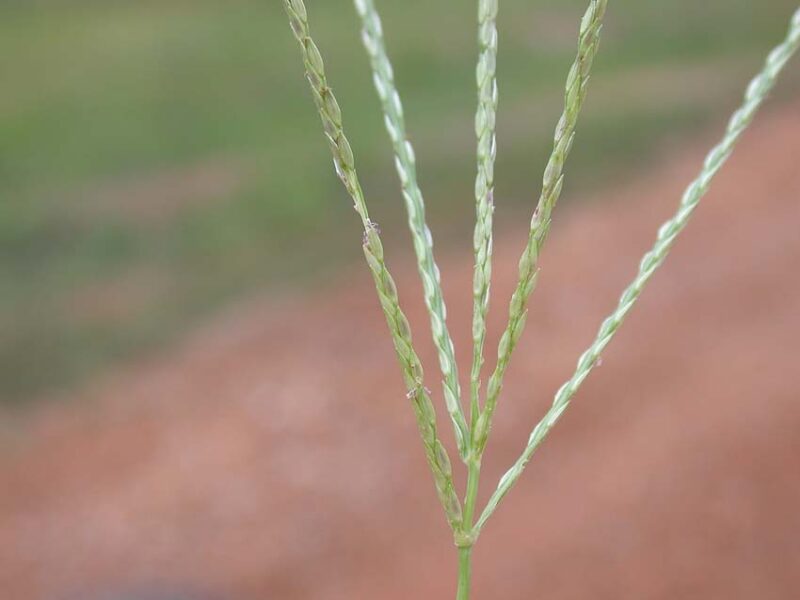
Remember, each plant can produce thousands of seeds. Remove immature seed heads as soon as you see them. Once the crabgrass seed heads have fully matured, pulling them will scatter the seeds, so it’s best to leave them alone.
If you pull up a mature crabgrass plant that has gone to seed, you disturb the soil and scatter seeds into the hole, providing optimum growing conditions for new crabgrass plants to sprout.
Killing Existing Crabgrass Plants
Before it becomes established, you can use pre-emergent herbicides that target germinating seeds, known as crabgrass preventers. Once crabgrass becomes established, however, you need to switch gears.
There are several ways to kill established crabgrass plants. Employing a variety of methods will improve your chances of success.
You can use selective herbicides that target crabgrass, known as crabgrass killers, and there are also several methods for organically and naturally killing crabgrass plants.
Use a combination of these methods in your battle against crabgrass. The goal is to keep it from taking over your lawn and going to seed.
Before Getting Started
Timing is everything when you’re eradicating crabgrass. Before you start, understand the crabgrass life cycle to know the best time to take action. Double-check to ensure that the weed you’re targeting is crabgrass.
Success lies in knowing your options, planning your attack, and gathering the required tools and materials. Then, all you need to do is follow through on your plan, and when you stay on top of it, killing crabgrass is easier.
When to Kill Crabgrass?
You can kill crabgrass throughout its life cycle by employing various methods.
Germination: Pre-emergent herbicides prevent seeds from growing into established plants by preventing germination and inhibiting root development. Also called crabgrass preventers, pre-emergents come in liquid or granular form and should be applied early in the spring.
Seedling: Pre-emergents work for two to six months to keep seedlings from taking root. They aren’t all the same, though, so be sure to check the packaging for more detailed information.
Growth: Selective post-emergent herbicides work best after crabgrass establishes roots and enters the growth stage.
Reproduction: When you see immature seed heads, remove them. In the fall, you can mow your lawn short, encouraging the germination of any seeds that have had a chance to mature. As soon as it freezes, they’ll die.
Dormancy: Crabgrass seed is dormant during the winter. You’ll have to wait until spring to start again.
Tools Required
- Weeding tool
- Pump sprayer
- Broadcast spreader
- Garden rake
- Spade
- Pump sprayer
- Safety glasses
- Gardening or work gloves
- Long-sleeved shirt and pants
Materials Required
- Grass seed
- Post-emergent herbicide
- Pre-emergent herbicide
- Broadcast spreader
- Weed sprayer
- Organic compost
- Straw
How to Kill Crabgrass With Pre-Emergent Herbicide
Pre-emergent herbicides, or crabgrass preventers, are an excellent way to control crabgrass. They work by preventing the germination of weed seeds and blocking the growth of newly emerged crabgrass seedlings.
Follow these steps for effective crabgrass control.
Measure the Lawn
Measure your lawn and follow the recommendations on the package to mix the proper amount of pre-emergent herbicide.
Apply Fertilizer Mixed with Weed Killer

Many pre-emergent herbicides are mixed with liquid or granular fertilizers, making it easy to do two jobs simultaneously.
Always wear protective clothing and eyewear when mixing and applying herbicides and fertilizers. Use a pump sprayer to apply liquid products and a broadcast spreader to apply granular products.
Water will activate pre-emergents, so apply them before it rains. It will also help the fertilizer in the product reach the roots.
Check out our Guide to Organic Fertilizer!
Reapply Crabgrass Preventers
Crabgrass preventers don’t kill seeds. Instead, they inhibit the growth of seedlings that have germinated.
Crabgrass will continue to sprout throughout the growing season, so you need to reapply pre-emergents two to three times each year. Remember that crabgrass preventers don’t work on established plants.
Reseed the Area
Wait at least two months before reseeding after using pre-emergent herbicides.
Crabgrass Preventers Timing
The key to using pre-emergents is to apply them before seeds germinate. Since crabgrass seeds sprout throughout the growing season, you can use them two to three times per year.
Natural processes in the soil break down the chemicals in crabgrass preventer. Applying it at the right time ensures its effectiveness.
Wait until the soil is about 52°F (11°C) before using it. For easy reference, this timing correlates with lilacs blooming, usually between your second and third mowings.
You can also apply crabgrass preventers in the fall unless you plan to seed your lawn then. You can start using it when the temperatures drop to 70°F and continue to fall. However, you should know that any crabgrass germinating in the fall will die when it freezes, so applying it too late would be a waste.
How to Kill Crabgrass With Post-Emergent Herbicide
Apply post-emergent herbicides in conjunction with pre-emergents to combat crabgrass effectively.
Choose a selective herbicide that targets crabgrass. Nonselective herbicides, such as glyphosate, kill all plants they come in contact with, so be careful to choose the right type. If you have a terrible crabgrass infestation, you can apply a nonselective herbicide to kill the entire area and start over.
Always wear protective clothing and eyewear when handling herbicides, and apply them carefully. Make notes about application dates to gauge their effectiveness and prevent overapplication.
Mix Herbicide
While crabgrass preventers are applied broadly over an entire area, you should use a spot application method with post-emergent herbicides. Mix concentrated herbicides with water according to the instructions on the package.
Spray the Crabgrass

Choose a hot, sunny day without wind to apply post-emergent herbicides. They work best when the ground is moist, but the plants are dry.
Spray individual patches or clumps of crabgrass, being careful to avoid other broadleaf plants, shrubs, and garden perennials. Thoroughly soak each clump, being sure to saturate the leaves.
Observe and Re-spray Patches of Crabgrass
It won’t take long to notice the effects of the post-emergent herbicide. The crabgrass should turn brown within a few days. Wait at least two days before watering, allowing the leaves to absorb the herbicide.
You should reapply if rain or watering washes the herbicide away. If the surrounding grass dies, you probably overapplied the post-emergent, and you can dilute the area with water to minimize the effects.
Remember that crabgrass is an annual and will naturally die in the fall. Using post-emergent herbicides late in the fall would be a waste.
How to Kill Crabgrass Naturally?
You can achieve crabgrass control without using harsh chemicals. The following method for killing crabgrass is effective, though it requires more work.
Soak the Soil
First, water the problem area and allow the water to soak in for about 30 minutes.
Pull Out the Crabgrass
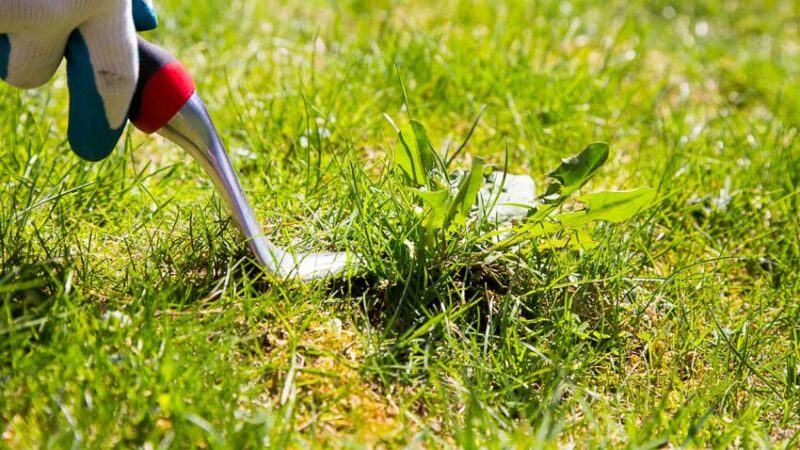
Once the soil is moist, pulling crabgrass out by the roots is easier. Use a small pitchfork or weeding tool, if necessary.
Add Compost
Pulling out large crabgrass plants will leave a hole in your lawn. Add compost, and work it into the surrounding area to encourage turfgrass growth.
Plant Turf Grass Seed
Next, plant turf grass seed in the compost. Place a small amount of weed-free mulch on top to protect the seeds.
Keep Watering the Soil
Over the next several days, water the soil in the problem area to encourage the seeds to germinate and develop roots.
Mow the New Grass
Crabgrass needs light and soil to germinate. If you mow your grass to a height of approximately three inches, leaving it relatively tall, it will prevent crabgrass from germinating in your lawn.
Weed Crabgrass as Needed
Continue to weed crabgrass as needed. Keep a small bag of compost and grass seed handy throughout the season to replant holes whenever you pull up crabgrass. Otherwise, the dormant crabgrass seed in the soil will take the opportunity to germinate there.
Other Methods to Kill Crabgrass Naturally
Here are some other natural methods to kill crabgrass in your lawn.
Boiling Water
Boiling water will kill plants, and you can use this method on a stubborn patch of crabgrass. Be careful about pouring it on any plants you want to keep because it won’t discriminate. You might have to pour boiling water on it a few times to kill it completely.
Vinegar
Spray undiluted vinegar on crabgrass. Choose a hot, sunny day and apply it generously to the entire plant. You should reapply a few times.
Citric Acid
Add powdered citric acid to water or use lemon juice concentrate, and mix with vinegar. Apply generously on a hot, sunny day and reapply every few days until the crabgrass dies.
Corn Gluten
Corn gluten is a byproduct of the corn milling process and is an effective and natural preemergent. Unlike chemical crabgrass preventers, it doesn’t keep seeds from germinating but keeps them from taking root.
It is not effective on established plants.
Solarize Crabgrass
This method is nonselective. It only works in areas where you wish to choke out all weeds.
Mow the problem area as low as possible and then water it. Next, leave a clear plastic sheet over the area for about six weeks. Once all the weeds are dead, you can replant with new turfgrass.
Natural Weed Killers
Natural weed-killer products safe for kids and pets are available. However, they aren’t more effective than homemade ones, which are much less expensive.
More Tips for Killing Crabgrass
Overseed in the Fall
Overseeding in the fall ensures that your lawn is lush and thick in the spring, keeping crabgrass from germinating.
Re-apply Weed Killer
Continue to apply weed killers as needed to eliminate crabgrass. Crabgrass control is most effective through persistent, well-timed applications of pre- and post-emergent herbicides.
Aerate the Lawn to Kill Crabgrass
The opportunistic crabgrass weed takes over when your lawn is weak and patchy. Aerating your lawn keeps it healthy and thick, and it is much more difficult for crabgrass to germinate in a lush, green lawn.

